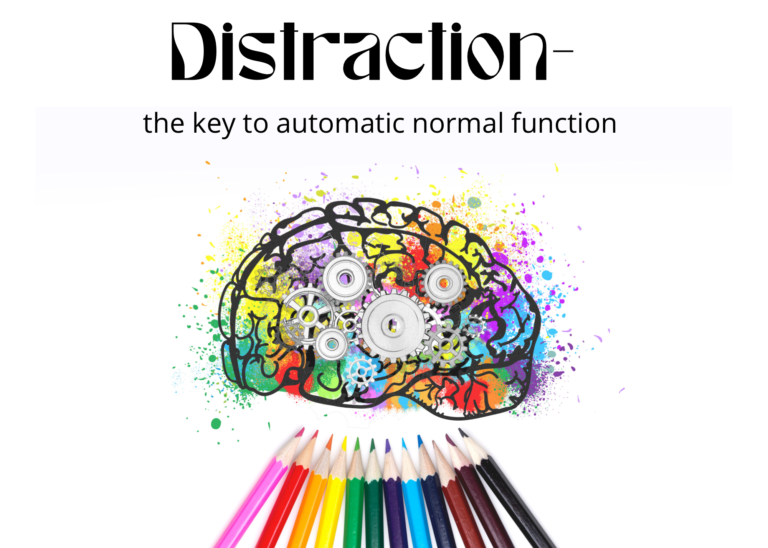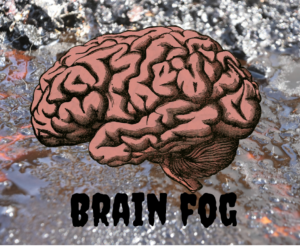
Distraction
Recently I had the privilege of attending the 2022 Functional Neurological Society’s international conference. What an inspiration that was! It was so exciting to see hundreds of medical providers eager to learn more about FND.
One frequent topic was the role of attention in FND. Redirecting attention is a cornerstone of FND treatment. One video shared by a speaker showed a woman with FND struggling to walk. Her gait was much like many of us have experienced firsthand- staggering, off-balance, and hesitant. Her difficulty was evident. However, while she was sitting while waiting for her next exercise, her phone rang. She popped out of her chair and walked over to answer it with no gait issues at all. For the uninitiated, it would appear that her mobility problems weren’t real. This is part of why we FND patients have been disbelieved for so long. When a neurologist is able to induce normal movement through distraction maneuvers, there is not much question about the diagnosis. One of the defining characteristics of Functional Neurological Disorder is our ability to function normally when we are distracted.
Another video I saw showed an FND patient whose gait looked fairly normal, but whenever he needed to turn, he began flailing and lost his balance. The physical therapist had him tap his leg as he moved into a turn. Tada! Problem solved! As long as he focused on tapping, his automatic movement through turns returned to normal.
During the early days of my functional neurological disorder, I remember that the inconsistency of my symptoms made me feel crazy. Why could I walk fine sometimes and other times my body refused to cooperate? It wasn’t due to any circumstance that I could figure out.
Now I know that my normal gait depends on automatic movement. I can’t focus on my walking. If I do, the connections go haywire.
Gait Recovery

Only you know what you can do safely! Please don't attempt any exercises that may cause injury.
When you are trying to walk and your legs won’t cooperate, the worst thing that you can do is to focus more on your legs. Success lies in accessing your automatic movements. Think back to when you were walking normally. You didn’t think about what you had to do when you walked, you just got up and did it. That’s the key to recovering your mobility.
Physical therapy can be very helpful with this. If you see a physical therapist who isn’t experienced with FND treatment, be sure to take along Glenn Nielsen’s landmark paper on FND treatment. While other patients who need to relearn to walk might need to focus on their legs, that approach will quickly backfire for those of us with FND.
Sometimes mixing it up a little bit with a movement that gets you moving, but isn’t normal walking, can help your brain avoid the unhelpful FND pattern. Try walking backwards, sidestepping, dancing, marching, changing your speed, sliding your feet as if you’re wearing skis, skipping, walking on tiptoe, or walking on your heels. Walking to the beat of your favorite music or counting out loud as you take steps can also provide distraction. Use any successful attempts at moving as a way to reassure yourself that your muscles are fine, it’s just a brain pathway issue.
Keep your mind off of walking by tapping your legs, singing, counting, or talking. When my legs threaten to give up the normal pattern, it helps me to focus on the spot I’m heading. I keep my gaze up on my target instead of looking at my feet like I used to do when FND was in charge. In my head I’m using words like “glide, smooth movement, easy, calm, relaxed” to remind myself of the feelings I need to stay in the normal automatic pathway.
When my legs feel weak, first I acknowledge the feeling so that I’m not just ignoring what my body is saying. Next up comes reassurance. I remind myself that I’ve had these sensations before, that they’re due to my FND, and that they will pass. It’s very easy to let our FND symptoms lead us into fear. “Why is this happening? Is it permanent? Are the doctors missing something? Surely this isn’t normal!” These thoughts are all understandable. I don’t know any FND patient who hasn’t had them. The problem is that fear causes our nervous system to enter an anxious state, accompanied by the stress hormones that can keep us from the calm, relaxed state that supports our best function.
If it’s been awhile since you’ve walked, don’t expect to just get up and go. Take it in small steps. You might start with a simple exercise moving from sitting to standing. Watch yourself in the mirror as you do this. You might be surprised to see that your form is very different from what you imagine. Watch the position of your feet on the floor and your bottom in the chair. Think about smooth, easy movements. Up, down. Up, down. Don’t overanalyze it.
Another exercise that you can try is weight shifting. Again, look in the mirror, stand up, and slowly shift your weight from side to side. This movement is fundamental to walking and can help your brain reconnect with those automatic patterns.
Tremors
If you have a tremor, you may have noticed that your doctor has performed a test that changes the tremor by initiating movement on the side opposite the tremor. This is called entrainment. For example, if you have an arm tremor on the right side, if you tap your left hand on your knee in a fixed rhythm, your tremor will take on the same rhythm. By slowly decreasing the speed of the tapping, you can slow down and even stop your tremor. Other tricks for distracting your tremor are to make competing movements, like waving your arms in an exaggerated manner like a musical conductor. Tap your toes, move your feet- anything that directs your attention to another body part and away from the part that suffers from a tremor.

Brain Fog
Most of us with FND go through those times when it feels like our brain is composed of sludge and thoughts just can’t get through. This happened to me the day after I returned home from the 2022 FND Society conference. I wasn’t surprised by the brain fatigue (which may have been part of the problem- our expectations play a powerful role in symptom development) after being away from home for several days, a conference with complicated lectures, a crowded conference room, and long flights.
In the past, this symptom has stumped me. I couldn’t figure out how to move out of the fog. This time, I was curious about how my garden was doing after my absence. After spending some time in the garden, I realized that the fog had lifted! I was so excited that my brain was back to processing thoughts normally.
As I thought about it, it made sense that just like my other symptoms, distraction could work to help brain fog too. Sometimes rest is your best option, but at other times, a soothing, calm activity might be just the ticket for clearing the fog.
Experiment!
What symptoms are you struggling with? I hope this post has given you some ideas for using distraction to keep your symptoms at bay. It’s not an all-inclusive list, however. Tools for distraction can be individualized. Experiment with ways to distract yourself from your symptoms and let me know what you find.


19 Comments
Great Blog and an encouraging perspective to share!
Hi Julie,
Thank you! I appreciate the work you do to help those of us with FND!
❤️Max
Hi Max
Just came across your info on this pesky FND newly diagnosed.
I know this is a very strange question but along with walking issues and forgetting names of things etc I have a really strange issue.
I have knitted all my life I can still knit but joining the pieces together is a challenge as my brain sees the pieces of cardigan different to usual and I keep sewing the little cardigans up incorrectly just wondered what part of FND this fits into 🤦♀️🤦♀️🤦♀️
Hi Karen,
I’m sorry to hear about your new FND diagnosis, but assure you that you’re in good company. The symptoms can be so strange, can’t they? I understand what you mean about the knitting issue. Sometimes if feels like my brain just checks out on tasks I’ve been performing all of my life. In my mind, it’s probably a cognitive issue. FND can affect so many things! My suggestion would be to be sure to attempt the difficult part of the project when your brain is rested and seeming to work fairly well. For some projects that I do that trip me up, I write out instructions or draw diagrams to remind me of the correct way to proceed. Good luck!
All the best,
Max
So glad I stumbled across your blog. What about episodes of total vision loss? Any suggestions? Thank you so much!
Hi Heather,
Vision loss isn’t something that I’ve experienced, so I’m afraid that I can’t be much help with that. If I find any helpful information, I’ll let you know. Wishing you the best- that’s got to be such a frustrating symptom.
Warmly,
Max
I’ve had single eye vision loss which was diagnosed as a visual migraine
I do believe it occurs with FND. As fnd is a nervous system disorder worsened by periods of fight, flight or freeze, I have read in books written by world class trauma experts that temporary blindness can occur. It has been well documented that during war times, pilots on bombing missions would experience this. I have experienced tunnel vision when in a state of great fear. Being in a ‘freeze’ state can cause many unusual symptoms. Dr Steven Porges is the expert on Polyvagal Theory used by many therapists. This teaching has given me much understanding as to the importance of retraining my nervous system. Therapy for trauma is a big part of it. I am seeing good results.
Absolutely loved this info, could so relate, thanks 🌈 and so helpful,
Thanks for reading, Bev!
All the best,
Max
Hey Max thanks! Brain is something I noticed but didn’t realize what happened like your garden. The last few years I have noticed that in my days I would play video games as distraction and have kind of had to do the opposite of the blog in focusing my attention. Someone pointed this blog out in an US/Canada FND Hope Zoom meeting and grateful.
Not something you talked about but I’m trying to get ideas together and sharing within groups of FND patients for how to deal with symptoms and for those outside to understand. My biggest symptom is trouble sleeping and was wondering if we could connect to discuss possible things to help in forms of distraction to help. I will say up front i you meditation music and guide meditation but sometimes it triggers me and I have to stop them
Thanks
Ross Whisenhunt
Hi Ross,
I’m glad to hear that my blog is being shared! Happy to connect anytime. Feel free to email me at FNDRecovery@gmail.com
Max
Hi Ross, Sleep is an issue with me too. I try to have a sleep schedule which sometimes works and sometimes doesn’t. My Dr prescribed Trazadone 100mg and Clonazepam nightly. I have to take it right when I am going to bed because it will make you hungry if you take it too soon. Most nights this works.
Hi Max, thank you so much for providing all of this information. I have felt so lonely and isolated with this struggle with FND since 2015. I’m so glad I found your blog.
Hi Lisa,
I’m glad you found me too! It can feel very isolating to have FND, but you’re definitely not alone. All the best to you as you learn to manage your FND.
Max
Hi does anyone here suffer from insecurities with FND? I have always been a professional with so much confidence and now I am so insecure I don’t know how to cope? Due to several daily seizures and vision problems I am no longer able to drive or work and I feel so bad 😢
Hi JB,
Are you seeing a therapist? Therapy can be so helpful for issues like this. It’s the only thing that’s helped me survive some of the darkest days of FND.
Wishing you the best,
Max
Any ideas on distraction techniques for speech affected by FND? Hard to think of things to distract whilst talking!
Hi Louise, This is one of my main problems these days. Thankfully, my mirror technique does the trick for me. I made a video of it that you can find on my YouTube channel here.YouTube I hope this technique is helpful for you too. Now that most of us have a smart phone handy, using the camera on yourself provides an instant mirror.
Good luck!
Max